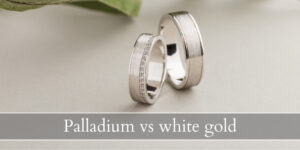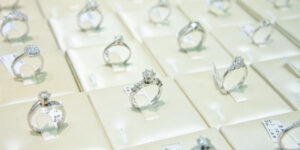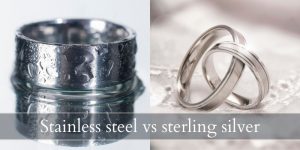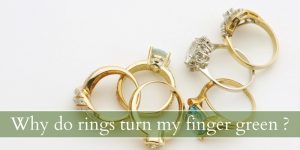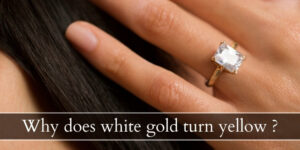Wondering if gold is the jewelry metal for you ? You might be wondering if this is a metal you’ll be comfortable wearing and whether it will scratch and tarnish over time, like silver for example. Well, it turns out the answer to whether gold tarnishes or not isn’t a simple yes or no, because there is pure gold and then there is jewelry gold. Let us explain.
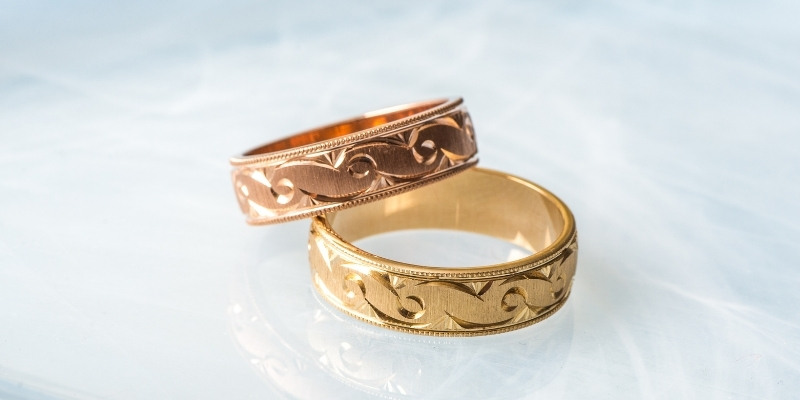
Does gold tarnish ?
Pure 24k gold does not tarnish, but jewelry gold is always alloyed with other metals (zinc, copper, nickel) and can indeed tarnish. The lower the karat of the gold, the more alloys it has, and the faster it will tarnish. 18k and 22k tarnish the slowest, as they have the most pure gold of all the jewelry gold versions. 14k gold is half and half so it’s generally safe but will still darken in time, just not as fast as silver.
Why does gold jewelry tarnish ?
The tarnish in gold alloy jewelry is caused by the base metals reacting to oxygen and sulfur in the air and on your skin. As you wear the jewelry you sweat, use perfume, hairspray, expose the jewelry to the air, and a thin film of tarnish (corrosion) forms on the outer part of the jewelry.
Again, not all gold jewelry will tarnish at the same rate. The higher the karat, the slower the tarnish. If you’re wearing an 18k yellow gold ring it will show signs of tarnishing only after a decade or so of regular wear, possibly later. A 14k one will show a bit faster than that, and a 10k one will show in a couple of years.
It depends on the amount of alloy metals, but also your personal chemistry. Some people sweat more, and some people have a more acidic sweat than others, and these people will unfortunately find that both gold and silver may tarnish faster for them.
Read also: Trellis VS Cathedral Setting
Does gold leave a black or green stain on your skin ?
Gold can leave a green or black mark on your skin if it is 1) a low karat gold alloy and 2) contains either copper or nickel. Copper is usually found in rose gold, while nickel can be found in all gold alloys.
Jewelry gold is alloyed with other metals because pure 24k gold is too soft to use for anything. It bends and breaks easily, so it needs to be hardened in order to be worn as jewelry or used in any sort of ornament.
The usual karats or alloys are:
- 22k has 91.70% pure gold
- 18k has 75% pure gold
- 14k has 58.50% pure gold
- 10k has 41.70% pure gold
Anything lower than 10k contains far too little gold to be used for jewelry, and 24k gold is pure gold that has not been mixed with anything at all. The usual alloy metals in gold jewelry are silver, zinc, copper, nickel, platinum, or palladium, in any combination a jeweler sees fit.
Does rhodium-plated gold tarnish ?
The rhodium plating on gold does not tarnish at all, but it can rub off after several years of continued wearing. And if the gold under the rhodium plating is a low karat one, then it might tarnish. But this is very unlikely to happen. Usually you’ll get a rhodium platin on white gold, which is usually alloyed with palladium or platinum, so it won’t tarnish unless the alloy is nickel.
Does tarnished gold mean it’s fake ?
No, tarnished gold does not mean it is fake gold but it does mean it’s not 100% pure gold. Pure gold cannot be worn in jewelry, which is why all gold jewelry is alloyed. Lower karat gold will tarnish faster than higher karat gold.
There are cases where the gold is not actual gold, not even jewelry gold. These are usually cheaper jewelry pieces you can find at fashion stores, and they never have a karat stamp on them. These ‘gold’ pieces can and will corrode and leave a green of black mark on your skin if worn for several hours and especially if you sweat in them.
How do you know it’s real gold ?
Real gold can be verified in two ways: look for a stamp, or perform an acid test. Either method will reveal the karat of the gold. The stamp method is the quickest and does not damage the jewelry at all. Here’s a quick rundown of both methods.
1. Look for the stamp
In a gold piece there is always a karat stamp. It may look different depending on the company as some prefer to stamp the exact karat number while other prefer to stamp the karat percentage.
For example a 14k gold piece can be stamped either ’14k’ or ‘585’. The ‘585’ refers to the 58.50% of pure gold in the alloy. Similarly you can find 18k gold stamped as ’18k’ or ‘750’ (as in 75% pure gold).
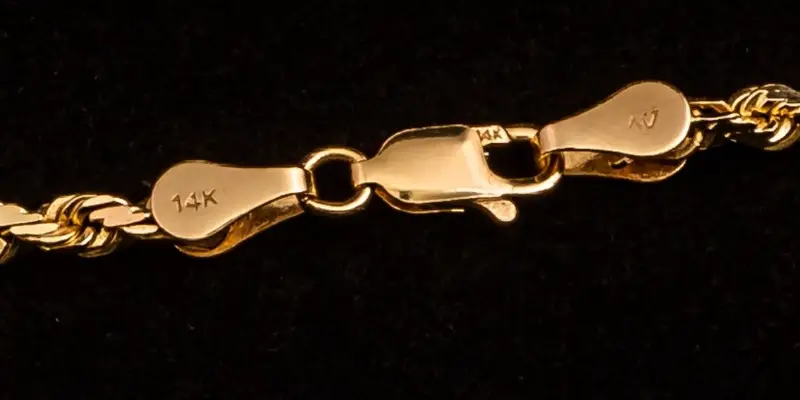
Some companies (very few) stamp with ‘ct’ instead of ‘k’, but the meaning is the same. You will usually find the stamp in a small place on the jewelry, hidden so it doesn’t detract from the overall look. So for example on rings it will be on the inside of the band, on necklaces and bracelets it’s usually on the clasp, and on earrings it’s usually somewhere on the backing or the post (if a stud).
2. Go to a jeweler to perform an acid test
The second method involves going to a jeweler to test the gold piece. The jeweler will take the gold and scratch it in a place where it won’t be immediately visible, such as the inside of the ring or the bac of an earring. Then they will place a drop of acid on the gold filings. Pure gold does not react to acid, while alloyed gold will react in a small amount. Base metals change colors completely.
If the gold filings turn any color at all, it is not gold and it is either a plated piece or one fo the fashion pieces we discussed earlier. This will usually turn green (brass).
How to remove tarnish from gold jewelry
You can remove tarnish from your gold jewelry at home, but to a point. If it is a heavily tarnished piece you might need professional help. But it’s it’s a light tarnish, like a few darker spots then you can easily clean the gold at home.
Do not use toothpaste or baking soda to remove tarnish, they are abrasive. If using a toothbrush use the softest you can find. Use phosphate-free dish soap and warm water, scrub, then pat dry with cotton towel. If you’re worried about scratching the gold you can swap the soft toothbrush for a cotton swab instead.
Does gold scratch ?
Yes, gold does scratch, even the lower karat ones. Pure gold (24k) is very soft and thus very easy to scratch. Higher karat gold like 18k will scratch easier than 14k gold, which scratches easier than 10k gold.
Gold has a Mohs rating of 2.5, which is very soft and the same as pure silver. Platinum has a 4-4.5 rating while palladium has a score of 4.75 on the same scale. These are common alloys for gold, so they raise the hardness of gold alloys by a few decimals. Still, gold jewelry is easy to scratch. Those scratches can only be removed two ways: buffing them with a very find buffer, which essentially strips a fine layer of gold off so it’s all even, or filling them in, which is more complicated than it sounds and not worth the effort.
A jeweler is definitely able to get you your gold jewelry back to its original shine, but it takes a bit of time.

I’m the main author for jewelrymaterialguide.com. I started this site after we did tons of research before our wedding and noticed that there is information about rings, jewelry, and so on that is really hard to find on the internet.

